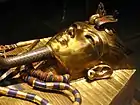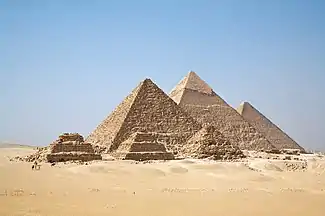Howard Carter
Howard Carter (9 May 1874 – 2 March 1939) was an English archaeologist and Egyptologist. He became world-famous after discovering the intact tomb of the 18th Dynasty Pharaoh, Tutankhamun in November 1922. Tutankhamun's tomb is famous because of the treasures it held intact for over three thousand years; it is the best-preserved pharaonic tomb found in the Valley of the Kings.
Howard Carter | |
|---|---|
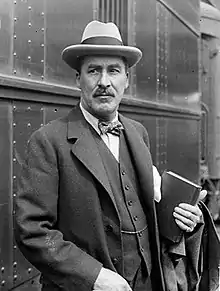 Howard Carter | |
| Born | 9 May 1874 Kensington, England |
| Died | 2 March 1939 (aged 64) Kensington, England |
| Nationality | British |
| Known for | Discovery of the tomb of King Tutankhamun |
| Scientific career | |
| Fields | Archaeology and Egyptology |
Early life
Howard Carter was born in Kensington on 9 May 1874, the youngest child (of eleven) of artist and illustrator Samuel John Carter and Martha Joyce (née Sands). His father helped train and develop his artistic talents.[1]
Carter spent much of his childhood with relatives in the Norfolk market town of Swaffham, the birthplace of both his parents.[2][3] Receiving only limited formal education at Swaffham, he showed talent as an artist. The nearby mansion of the Amherst family, Didlington Hall, contained a sizable collection of Egyptian antiques, which sparked Carter's interest in that subject. Lady Amherst was impressed by his artistic skills, and in 1891 she prompted the Egypt Exploration Fund (EEF) to send Carter to assist an Amherst family friend, Percy Newberry, in the excavation and recording of Middle Kingdom tombs at Beni Hasan.[4]
Although only 17, Carter was innovative in improving the methods of copying tomb decoration. In 1892, he worked under the tutelage of Flinders Petrie for one season at Amarna, the capital founded by the pharaoh Akhenaten. From 1894 to 1899, he worked with Édouard Naville at Deir el-Bahari, where he recorded the wall reliefs in the temple of Hatshepsut.[5]
In 1899, Carter was appointed Inspector of Monuments for Upper Egypt in the Egyptian Antiquities Service (EAS).[6] Based at Luxor, he oversaw a number of excavations and restorations at nearby Thebes, while in the Valley of the Kings he supervised the systematic exploration of the valley by the American archaeologist Theodore Davis.[5] In 1904, after a dispute with local people over tomb thefts, he was transferred to the Inspectorate of Lower Egypt.[7] Carter was praised for his improvements in the protection of, and accessibility to, existing excavation sites,[8] and his development of a grid-block system for searching for tombs. The Antiquities Service also provided funding for Carter to head his own excavation projects.
Carter resigned from the Antiquities Service in 1905 after a formal inquiry into what became known as the Saqqara Affair, a violent confrontation between Egyptian site guards and a group of French tourists. Carter sided with the Egyptian personnel, refusing to apologise when the French authorities made an official complaint.[9] Moving back to Luxor, Carter was without formal employment for nearly three years. He made a living by painting and selling watercolours to tourists and, in 1906, acting as a freelance draughtsman for Theodore Davis.[10]
Tutankhamun's tomb
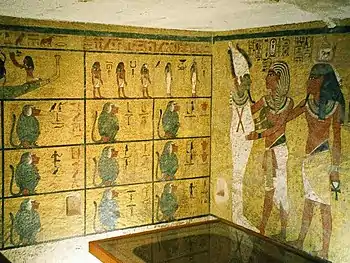
In 1907, he began work for Lord Carnarvon who employed him to supervise the excavation of nobles' tombs in Deir el-Bahri, near Thebes.[11] Gaston Maspero, head of the Egyptian Antiquities Service, had recommended Carter to Carnarvon as he knew he would apply modern archaeological methods and systems of recording.[12]
.jpg.webp)
In 1914, Lord Carnarvon received the concession to dig in the Valley of the Kings.[13] Carter was again employed to lead the work. He undertook a systematic search for any tombs missed by previous expeditions, in particular that of the Pharaoh Tutankhamun. However, excavations were soon interrupted by the First World War, Carter spending the war years working for the British Government as a diplomatic courier and translator. He enthusiastically resumed his excavation work towards the end of 1917.[14]
By 1922, Lord Carnarvon had become dissatisfied with the lack of results after several years of finding little. After considering withdrawing his funding, Carnarvon agreed, after a discussion with Carter, that he would fund one more season of work in the Valley of the Kings.[15]
Carter returned to the Valley of Kings, and investigated a line of huts that he had abandoned a few seasons earlier. The crew cleared the huts and rock debris beneath. On 4 November 1922, their young water boy accidentally stumbled on a stone that turned out to be the top of a flight of steps cut into the bedrock.[16] Carter had the steps partially dug out until the top of a mud-plastered doorway was found. The doorway was stamped with indistinct cartouches (oval seals with hieroglyphic writing). Carter ordered the staircase to be refilled, and sent a telegram to Carnarvon, who arrived from England two-and-a-half weeks later on 23 November, accompanied by his daughter Lady Evelyn Herbert.[17]
On 24 November 1922, the full extent of the stairway was cleared and a seal containing the Tutankhamun's cartouche found on the outer doorway. This door was removed and the rubble-filled corridor behind cleared, revealing the door of the tomb itself.[18] On 26 November Carter, with Carnarvon, Lady Evelyn and assistant Arthur Callender in attendance, made a "tiny breach in the top left-hand corner" of the doorway, using a chisel that his grandmother had given him for his 17th birthday. He was able to peer in by the light of a candle and see that many of the gold and ebony treasures were still in place. He did not yet know whether it was "a tomb or merely an old cache", but he did see a promising sealed doorway between two sentinel statues. Carnarvon asked, "Can you see anything?" Carter replied with the famous words: "Yes, wonderful things!"[19] Carter had, in fact, discovered Tutankhamun's tomb (subsequently designated KV62).[20] The tomb was then secured, to be entered in the presence of an official of the Egyptian Department of Antiquities the next day.[21] However that night, Carter, Carnarvon, Lady Evelyn and Callender apparently made an unauthorised visit, becoming the first people in modern times to enter the tomb.[22][23][24] Some sources suggest that the group also entered the inner burial chamber.[25] In this account, a small hole was found in the chamber's sealed doorway and Carter, Carnarvon and Lady Evelyn crawled through.[24]
The next morning, 27 November, saw an inspection of the tomb in the presence of an Egyptian official. Callender rigged up electric lighting, illuminating a vast haul of items, including gilded couches, chests, thrones, and shrines. They also saw evidence of two further chambers, including the sealed doorway to the inner burial chamber, guarded by two life-size statues of Tutankhamun.[26] In spite of evidence of break-ins in ancient times, the tomb was virtually intact, and would ultimately be found to contain over 5,000 items.
On 29 November the tomb was officially opened in the presence of a number of invited dignitaries and Egyptian officials.[27]
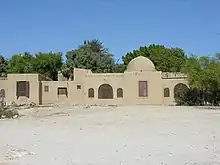
Realising the size and scope of the task ahead, Carter sought help from Albert Lythgoe of the Metropolitan Museum's excavation team, working nearby, who readily agreed to lend a number of his staff, including Arthur Mace and archaeological photographer Harry Burton,[28] while the Egyptian government loaned analytical chemist Alfred Lucas.[29] The next several months were spent cataloguing and conserving the contents of the antechamber under the "often stressful" supervision of Pierre Lacau, director general of the Department of Antiquities of Egypt.[30] On 16 February 1923, Carter opened the sealed doorway and confirmed it led to a burial chamber, containing the sarcophagus of Tutankhamun. The tomb was considered the best preserved and most intact pharaonic tomb ever found in the Valley of the Kings, and the discovery was eagerly covered by the world's press. However, much to the annoyance of other newspapers, Lord Carnarvon sold exclusive reporting rights to The Times. Only H. V. Morton of that paper was allowed on the scene, and his vivid descriptions helped to establish Carter's reputation with the British public.[31]
Towards the end of February 1923, a rift between Lord Carnarvon and Carter, probably caused by a disagreement on how to manage the supervising Egyptian authorities, temporarily halted the excavation. Work recommenced in early March after Lord Carnarvon apologised to Carter.[32] Later that month Lord Carnarvon contracted blood poisoning while staying in Luxor near the tomb site. He died in Cairo on 5 April 1923.[33] Lady Carnarvon retained her late husband's concession in the Valley of the Kings, allowing Carter to continue his work.
Carter's meticulous assessing and cataloguing of the thousands of objects in the tomb took nearly ten years, most being moved to the Egyptian Museum in Cairo. There were several breaks in the work, including one lasting nearly a year in 1924–25, caused by a dispute over what Carter saw as excessive control of the excavation by the Egyptian Antiquities Service. The Egyptian authorities eventually agreed that Carter should complete the tomb's clearance.[34] This continued until 1929, with some final work lasting until February 1932.[35]
Despite the significance of his archaeological find, Carter received no honour from the British government. However, in 1926, he received the Order of the Nile, third class, from King Fuad I of Egypt.[36] He was also awarded an honorary degree of Doctor of Science by Yale University and honorary membership in the Real Academia de la Historia of Madrid, Spain.[37]
Carter wrote a number of books on Egyptology during his career,[38] including Five Years' Exploration at Thebes, co-written with Lord Carnarvon in 1912, describing their early excavations,[39] and a three-volume popular account of the discovery and excavation of Tutankhamun’s tomb.[40] He also delivered a series of illustrated lectures on the excavation, including a 1924 tour of Britain, France, Spain and the United States.[41] Those in New York City and other US cities were attended by large and enthusiastic audiences, sparking American Egyptomania.[42]
Personal life
The suggestion that Carter had an affair with Lady Evelyn Herbert,[43] the daughter of the 5th Earl of Carnarvon, was later rejected by Lady Evelyn herself, who told her daughter Patricia that "at first I was in awe of him, later I was rather frightened of him", resenting Carter's "determination" to come between her and her father.[44] More recently, the 8th Earl dismissed the idea, describing Carter as a "stoical loner".[45] Harold Plenderleith, a former associate of Carter's at the British Museum, was quoted as saying that he knew "something about Carter that was not fit to disclose", perhaps suggesting that Plenderleith believed that Carter was homosexual.[46] There is, however, no evidence that Carter enjoyed any close relationships throughout his life,[47] and he never married nor had children.[42]
Later life
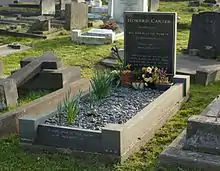
After the clearance of the tomb had been completed in 1932 Carter retired from excavation work. He continued to live in his house near Luxor in winter and retained a flat in London but, as interest in Tutankhamun declined, he lived a fairly isolated existence with few close friends.[48] He acted as a part-time agent for collectors and museums, including the Cleveland Museum of Art and the Detroit Institute of Arts.
Death
Carter died at his London flat at 49 Albert Court, next to the Royal Albert Hall, on 2 March 1939, aged 64 from Hodgkin's Disease.[49][50][51][52] He was buried in Putney Vale Cemetery in London on 6 March, nine people attending his funeral.[53]
The epitaph on his gravestone reads: "May your spirit live, may you spend millions of years, you who love Thebes, sitting with your face to the north wind, your eyes beholding happiness", a quotation taken from the Wishing Cup of Tutankhamun,[54] and "O night, spread thy wings over me as the imperishable stars".[55]
Probate was granted on 5 July 1939 to Egyptologist Henry Burton and to publisher Bruce Sterling Ingram. Carter is described as Howard Carter of Luxor, Upper Egypt, Africa, and of 49 Albert Court, Kensington Grove, Kensington, London. His estate was valued at £2,002. The second grant of Probate was issued in Cairo on 1 September 1939.[56] In his role as executor, Burton identified at least 18 items in Carter's antiquities collection that had been taken from Tutankhamun's tomb without authorisation. As this was a sensitive matter that could affect Anglo-Egyptian relations, Burton sought wider advice, finally recommending that the items be discreetly presented or sold to the Metropolitan Museum of Art, with most eventually going either there or to the Egyptian Museum in Cairo.[57] The Metropolitan Museum items were later returned to Egypt.[58]
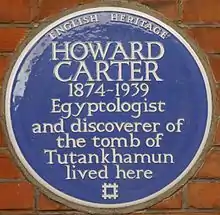
In popular culture
Carter's discovery of Tutankhamun's tomb revived popular interest in Ancient Egypt – 'Egyptomania' – and created "Tutmania", which influenced popular song and fashion.[59] Carter used this heightened interest to promote his books on the discovery and his lecture tours in Britain, America and Europe.[41] While interest had waned by the mid 1930s,[60] from the early 1970s touring exhibitions of the tomb's artefacts led to a sustained rise in popularity. This has been reflected in TV dramas, films and books, with Carter's quest and discovery of the tomb portrayed with varying levels of accuracy.[61]
Dramas
Carter has been portrayed or referred to in many film, television and radio productions:[62]
- In the Columbia Pictures Television film The Curse of King Tut's Tomb (1980), he is portrayed by Robin Ellis.
- In the 1981 film Sphinx, he is portrayed by Mark Kingston.
- In the Lucasfilm TV films Young Indiana Jones and the Curse of the Jackal (1992) and Young Indiana Jones and the Treasure of the Peacock's Eye (1995), he is portrayed by Pip Torrens.
- In the IMAX documentary Mysteries of Egypt (1998), he is portrayed by Timothy Davies.
- In the made-for-TV film The Tutankhamun Conspiracy (2001), he is portrayed by Giles Watling.
- In an episode of 2005 BBC docudrama Egypt, he is portrayed by Stuart Graham.
- He was portrayed in the 2008 Big Finish Radio Drama Forty-five, a title in the Doctor Who range, voiced by Benedict Cumberbatch.[63]
- As the main character in 2016 ITV miniseries Tutankhamun, portrayed by Max Irons.
Literature
- He is referenced in Hergé's volume 13 of The Adventures of Tintin: The Seven Crystal Balls (1948).[64]
- He is parodied in the 1979 book Motel of the Mysteries by David Macaulay, with a character in the book named Howard Carson.[65]
- He is a key character in Christian Jacq's 1992 book The Tutankhamun Affair.[66]
- James Patterson and Martin Dugard's 2010 book The Murder of King Tut focuses on Carter's search for King Tut's tomb.[67]
- He appears as a main character in Muhammad Al-Mansi Qindeel's 2010 novel A Cloudy Day on the West Side.[68]
- In Laura Lee Guhrke's 2011 historical romance novel Wedding of the Season, Carter's telegram to the fictional British Egyptologist, the Duke of Sunderland, reports discovering "steps to a new tomb" and creates a climactic conflict.[69]
- He is referenced in Sally Beauman's 2014 novel The Visitors, a re-creation of the hunt for Tutankhamun's tomb in Egypt's Valley of the Kings.[70]
- He is a main character in Philipp Vandenberg's 2004 book The King Of Luxor.[71]
References
- Newberry 1939, p. 67.
- Swaffham history Retrieved 12 November 2013.
- Swaffham museum Retrieved 20 May 2012.
- Winstone 2006, pp. 12–15.
- Newberry 1939, p. 68.
- Winstone 2006, p. 66.
- Winstone 2006, p. 87.
- Ford 1995, p. 19.
- Winstone 2006, pp. 88–92.
- Winstone 2006, pp. 93–95.
- Winstone 2006, p. 95.
- David, Elisabeth (1999). Gaston Maspero 1846-1916: le gentleman égyptologue. Paris: Pygmalion; Gérard Watelet. ISBN 2-85704-565-4.
- Price 2007, pp. 121-122.
- Price 2007, pp. 121–122.
- Carnarvon, Fiona (2011). Highclere Castle. Highclere Enterprises. p. 59.
- Christianson, Scott (5 November 2015). "A Look Inside Howard Carter's Tutankhamun Diary". Smithsonian Magazine. Retrieved 6 July 2018.
- Carter & Mace 1923, pp. 94–95.
- Winstone 2006, pp. 142–145.
- Reeves & Taylor 1992, p. 141, Lord Carnarvon's description, 10 December 1922.
- "KV 62 (Tutankhamen)". Archived from the original on 12 December 2007. Retrieved 31 December 2020.
- Carter & Mace 1923, p. 90.
- Lord Carnarvon, The Times (11 Dec 1922), cited in Winstone, p 154.
- Lucas 1942, pp. 135–147.
- Hoving, Chapter 9 1978.
- That the group entered the burial chamber is supported by Lucas and Hoving, but dismissed by Carnarvon in The Times, 11 Dec 1922.
- Carter & Mace 1923, pp. 101–104.
- Winstone 2006, p. 155.
- Ridley, Ronald T. The Dean of Archaeological Photographers: Harry Burton. Journal of Egyptian Archaeology, Vol. 99, 2013. California: SAGE Publishing. pp. 124–126.
- Winstone 2006, p. 297.
- Winstone 2006, p. 134 and passim.
- Winstone 2006, p. 179.
- Price 2007, pp. 130–131.
- "Report of Carnarvon's death". New York Times. 5 April 1923. Retrieved 12 August 2008.
- Price 2007, pp. 132–134.
- Winstone 2006, pp. 355–356.
- The Scotsman, Saturday 27 March 1926, page 8.
- "Howard Carter, 64, Egyptologist, Dies". New York Times. 3 March 1939. Retrieved 19 August 2018.
- "Howard Carter, 64, Egyptologist, Dies". Goodreads. 3 March 2018. Retrieved 19 August 2018.
- Carnarvon, Earl of; Carter, Howard (1912). Five Years' Exploration at Thebes. OCLC 474563606.
- Howard Carter, The Tomb of Tut.Ankh.Amen, 3 volumes.
- Cross 2006, p. 92.
- "Howard Carter". .historyonthenet.com. Retrieved 4 July 2020.
- Hoving 1978, p. 222.
- Winstone 2006, p. 321.
- Furness, Hannah (14 October 2016). "Row over Tutankhamun's tomb affair as ITV drama brings discovery to life". The Telegraph. Retrieved 24 April 2020.
- Oddy, Andrew (18 October 2016). "An inconvenient crush in King Tut's tomb". The Daily Telegraph. Retrieved 26 April 2020.
- James 2012, p. 463.
- Winstone 2006, pp. 322-325.
- James 2012, pp. 454–455.
- "Howard Carter, 64, Egyptologist, Dies". The New York Times.
- "From The Guardian archives – Egyptologist Howard Carter dies". The Guardian. Retrieved 11 January 2019.
- Reeves & Taylor 1992, p. 180.
- Winstone 2006, pp. 326–327.
- Reeves & Taylor 1992, p. 188.
- cf the prayer to the Goddess Nut found on the lids of New Kingdom coffins: "O my mother Nut, spread yourself over me, so that I may be placed among the imperishable stars and may never die."Text From Egypt Centre Trail: Reflections Of Women In Ancient Egypt". 2001. Archived from the original on 11 June 2011. Retrieved 28 April 2011.
- probatesearch.service.gov.uk Retrieved 2 March 2018.
- Winstone 2006, pp. 328–330.
- Hawass 2018, p. 23.
- Winstone 2006, p. 2.
- Winstone 2006, p. 324.
- Winstone 2006, p. viii.
- "Howard Carter (Character)". IMDb.com. Archived from the original on 8 November 2017.
- Doctor Who: Forty-Five
- Hergé (1944). The Seven Crystal Balls. The Adventures of Tintin. 13. Le Soir. ISBN 2-203-00112-7.
- Motel of the Mysteries, by David Macauley. Archived 15 February 2017 at the Wayback Machine Retrieved 13 January 2017.
- The Tutankhamun Affair Archived 27 September 2013 at the Wayback Machine Retrieved 23 May 2009.
- Patterson, Dugard, James, Martin (2010). The Murder of King Tut. Grand Central Publishing. ISBN 978-0-446-53977-7.
- Book reviews Retrieved 17 March 2010.
- Guhrke, Laura Lee (2011). Wedding of the Season. Avon Books. ISBN 978-0-06-196315-5.
- The Visitors Retrieved 20 March 2015.
- Der König Von Luxor Retrieved 27 December 2020.
- Redmond, J.; Ensor, D. (19 June 2005). "Cracking the code: Mysterious 'Kryptos' sculpture challenges CIA employees". CNN.
- "Howard Carter's 138th Birthday". Google Doodle. 9 May 2012. Retrieved 10 August 2015.
Sources and further reading
- Carnarvon, Fiona (2007). Carnarvon & Carter – The story of the two Englishmen who discovered the tomb of Tutankhamun. Highclere Enterprises.
- Carter, Howard; Mace, Arthur (1923). The tomb of Tut Ankh Amen, volume 1. London. OCLC 471731240.
- Cross, William (2006). Carnarvon, Carter and Tutankhamun Revisited: The Hidden Truths and Doomed Relationships. The author. ISBN 1-905914-36-9.
- Ford, Barbara (1995). Howard Carter, Searching for King Tut. New York: Freeman & Company. ISBN 0-7167-6587-X.
- Hawass, Zahi (2018). Tutankhamun. Treasures of the Golden Pharaoh. Melcher Media, New York. ISBN 978-1-59591-1001.
- Hoving, Thomas (1978). Tutankhamun: The Untold Story. New York: Simon & Schuster. ISBN 9780671243050.
- James, T. G. H. (2012). Howard Carter: The Path to Tutankhamun. London: Tauris Parke Paperbacks. ISBN 978-1-86064-615-7.
- Lucas, Alfred (1942). "Notes on some of the objects from the tomb of Tutankhamun". Annales du Service des Antiquités de l'Égypte (41).
- Newberry, P.E (1939). Howard Carter, obituary. Journal of Egyptian Archaeology, vol 25, no 1. June 1939. Egypt Exploration Society, London.
- Paine, Michael. Cities of the Dead; fiction (Howard Carter as narrator); copyright by John Curlovich; Charter Books Publishing, 1988 (ISBN 1-55773-009-1)
- Peck, William H. The Discoverer of the Tomb of Tutankhamun and the Detroit Institute of Arts. Journal of the Society for the Study of Egyptian Antiquities. Vol. XI, No. 2, March 1981, pp. 65–67
- Price, Bill (2007). Tutankhamun, Egypt's Most Famous Pharaoh. Pocket Essentials, Hertfordshire. ISBN 978-1842432402.
- Reeves, Nicholas; Taylor, John H. (1992). Howard Carter before Tutankhamun. London: British Museum. ISBN 0810931869.
- Vandenberg, Philipp. Der vergessene Pharao: Unternehmen Tut-ench-Amun, grösste Abenteuer der Archäologie. Orbis, 1978 (ISBN 3570031195); translated as The Forgotten Pharaoh: The Discovery of Tutankhamun. London: Hodder and Stoughton, 1980 (ISBN 0340246642)
- Winstone, H.V.F. (2006). Howard Carter and the discovery of the tomb of Tutankhamun (Rev edn). Barzan, Manchester. ISBN 1-905521-04-9. OCLC 828501310.
External links
| Wikiquote has quotations related to: Howard Carter |
| Wikimedia Commons has media related to Howard Carter. |
- Five Years' Explorations at Thebes
- Schulz, Matthias (15 January 2010). "Did King Tut's Discoverer Steal from the Tomb?". Der Spiegel Online. Retrieved 19 January 2010.
- Works by or about Howard Carter in libraries (WorldCat catalog)
- Newspaper clippings about Howard Carter in the 20th Century Press Archives of the ZBW
